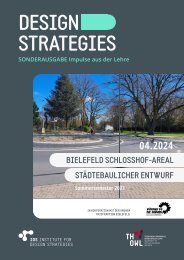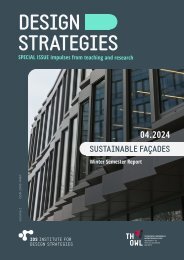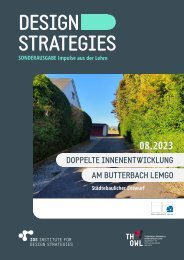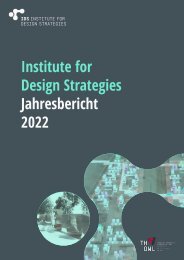urbanLab Magazin 2021 - Transformation
Erfolgreiche ePaper selbst erstellen
Machen Sie aus Ihren PDF Publikationen ein blätterbares Flipbook mit unserer einzigartigen Google optimierten e-Paper Software.
The buildings around us are immovable,<br />
although they are surrounded by a<br />
constantly dynamic and changing environment.<br />
Advanced technology has allowed<br />
designers to develop an architecture<br />
that responds to the environment<br />
and brings dynamics to the building.<br />
Mainly focusing on the environmental<br />
factors, these kinetic facades are solving<br />
the problem of architecture by adapting<br />
to the natural environment. This<br />
helps to create a better physical comfort<br />
for the human inside the building.<br />
However, it is necessary not to forget<br />
that the inhabitants that observers this<br />
architecture are also a vital part of this<br />
dynamic environment. Preliminary investigation<br />
shows that, unfortunately,<br />
human interaction is missing in most<br />
of the case studies of kinetic architecture.<br />
On the other hand sculptures and<br />
installations have adopted interactivity<br />
as a vital component, inherent to the<br />
works to capture an audience and bring<br />
visual aesthetics. Some architectural typologies<br />
like shopping areas, museums,<br />
and advertisement buildings could benefit<br />
from the integration of this artistic<br />
interactivity into the kinetic envelope.<br />
Interactive facades are part of the architecture<br />
field that focuses on the creation<br />
of spaces or building components<br />
that can perform actions based on environmental<br />
factors or with the needs<br />
of the user. This type of facade represents<br />
a connecting link that receives or<br />
senses the interactive behaviors of the<br />
environment around it and reacts back<br />
into space. In this case, the two necessary<br />
requirements are ubiquitous interaction<br />
and robotic transformation<br />
[Weiser, 1991]. Automated responsive<br />
facades and installations have become<br />
more popular nowadays and are commonly<br />
incorporated as a method for<br />
improving human comfort and energy<br />
efficiency in the building. From the analyzed<br />
information it is visible that most<br />
of the architectural objects respond to<br />
changes in real-time by using different<br />
kinds of sensors combined with different<br />
mechanisms. Unfortunately from<br />
the research, we learn that the value of<br />
human-interactive kinetic façades might<br />
be underestimated. For that reason, in<br />
the research paper, the focus is on the<br />
human as an object of interactivity.<br />
KINETIC FAÇADE<br />
Kinetic façade is the science of constructing<br />
buildings so that structural elements<br />
can move relative to each other<br />
without violating the overall integrity<br />
of the building. Kinetic facades often<br />
mediate between aesthetics and utility.<br />
Integrated with urban features the<br />
kinetic façade or installation should be<br />
programmable according to the wishes<br />
of the users and thus facilitate the<br />
perception of the urban space. It must<br />
also be interactive, as it is a key quality<br />
in kinetic facades. In the research paper<br />
of Ms. Kaviya Lakshmi Ayyappan and Ar.<br />
R. Meena Kumari [2018], stated that adding<br />
movement to a building façade can<br />
turn it into a kinetic sculpture that continuously<br />
presents new visual aspects in<br />
different variations.<br />
INTERACTIVE FAÇADE<br />
Fig.2: Human-interactive kinetic façade<br />
section diagram (own illustration)<br />
STUDENT IDEAS<br />
137
















